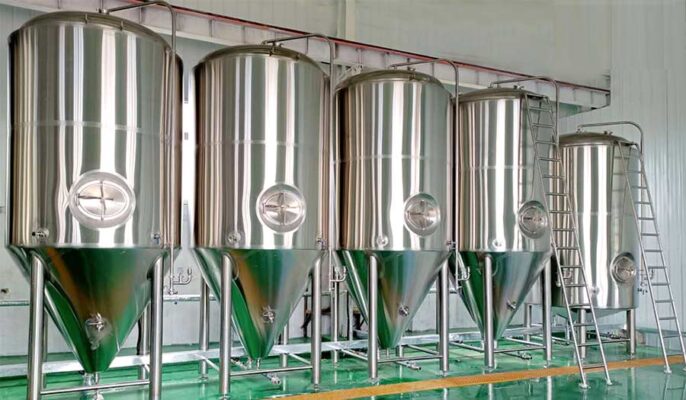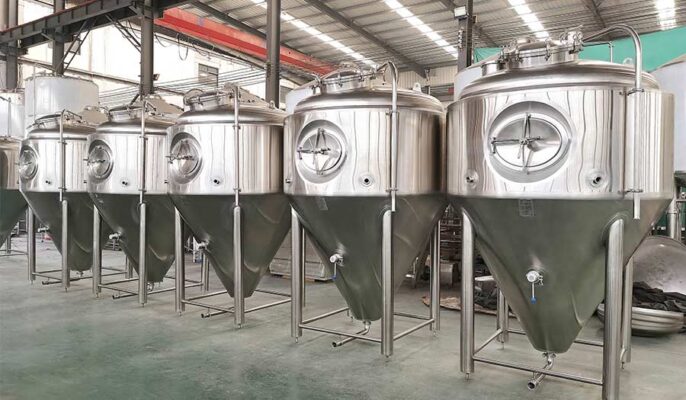A fermenter is an essential piece of equipment for anyone interested in brewing beer, brewing wine, or fermenting other beverages or foods. The main function of these tanks is to provide an optimal environment for fermentation microorganisms to convert sugar into alcohol and other by-products, thereby producing the desired end product.
What is a fermenter?
Fermentation tanks, also known as fermentation vessels, are specialized vessels designed for the fermentation process in various industries, especially in the production of alcoholic beverages such as beer and wine. The main function of these tanks is to provide an optimal environment for fermenting microorganisms to convert sugar into alcohol and other by-products.
Features of fermentation tanks:
- Material: Most fermentation tanks are made of stainless steel, which has excellent corrosion resistance and is easy to clean. This ensures the purity and quality of the final product.
- Temperature control: Fermentation is a temperature-sensitive process. Modern fermenters are equipped with cooling jackets or internal coils to regulate temperature.
- Sealed environment: To prevent contamination, the fermentation tank is sealed. This sealed environment ensures the consistent quality of the final product.
- Capacity: Tank sizes range from small homemade tanks of a few gallons to large commercial tanks holding thousands of gallons.

Types of fermenters
Open-top fermentation tank
A simple container without a lid or seal, is the most basic type of fermenter. They are used for fermenting wine because they allow easy access and manual pressing of the cap (the layer of grape skins and seeds that rise to the surface during fermentation).
Closed fermentation tank
Closed fermenters have a sealed lid that prevents any external contaminants from entering the fermentation process. They are used in brewing beer because they protect the liquid from exposure to air, which can cause spoilage or off-flavors.
Variable capacity fermentation tank
Variable capacity fermenters have floating lids and adjustable volumes, making them suitable for fermenting different amounts of liquid. They are popular among homebrewers and small brewers because they offer flexibility and help cut the amount of air contact with the fermenting liquid.
Differentiating Between Types of Fermenting Tanks:
|
TANK TYPE |
PRIMARY USE |
UNIQUE FEATURES |
|
Conical |
Beer |
Tapered bottom for easy yeast collection |
|
Open-Top |
Wine |
Allows for manual punch-down of grape cap |
|
Cylindroconical |
Versatile |
Combination of cylindrical and conical designs, popular in breweries |
|
Flat-Bottomed |
General |
Used in multiple industries beyond just beverages |
What materials are fermentation tanks made of?
Copper
Before stainless steel entered the market, copper was the metal of choice for manufacturing beer equipment. Copper has excellent thermal conductivity and is also a reliable metal for making beer equipment. Copper is also easy to clean and maintain. You can use detergent or sodium percarbonate cleaner to clean to ensure the cleanliness of the copper and the integrity of the oxide layer. But too much scrubbing can be harmful.
Aluminum
Aluminum can be made into brewing tanks, but it is not suitable for long-term storage of beer. The thermal conductivity of aluminum is half that of copper, but better than stainless steel. Under normal brewing conditions, it will not be corroded by the beer, nor will it add any metallic taste to the beer. Aluminum will corrode if it comes into long-term contact with other metals, including copper, but short-term exposure is acceptable. brewers using aluminum beer equipment choose grade 3003 or 3004 aluminum because of their excellent corrosion resistance.
Stainless steel
The use of stainless steel to manufacture beer equipment has become a standard in the beer industry, and most breweries dream of owning a complete set of stainless steel beer equipment. Stainless steel beer equipment is easy to sterilize, inert to beer, corrosion-resistant, and durable. Some breweries want the appearance of beer equipment to be copper-colored because copper color is more attractive to consumers. Now, copper cladding can be added to the perimeter of the stainless steel liner. Since copper does not come into contact with the beer, the before mentioned disadvantages of copper brewing equipment do not occur.
Different types of fermentation tanks
Continuous stirred tank fermentation tank
A continuous stirred tank reactor (CSTR) consists of a vessel with pipes, pumps, valves, stirrers, motors, shafts, and impellers. The shaft is located at the bottom of the tank and the number of impellers depends on the size of the bioreactor.
Airlift fermentation tank
Airlift bioreactors contain a baffle or draft tube in the middle through which air is pumped into the vessel. There are two types of airlift fermenters:
Internal circulation airlift bioreactor: It has a central drainage tube that provides an internal circulation channel.
External loop airlift bioreactor: It contains an external loop that separates the liquid flowing into separate channels.
Packed bed fermenter
In a packed bed fermenter, hollow tubes or tubes are filled with biocatalysts. Beds are stationary. The culture medium flows through the biocatalyst, which produces metabolites in the broth. These bioreactors are easy to operate but often become clogged due to poor oxygen circulation.
Membrane fermentation tank
Membrane bioreactors are used in conjunction with ultrafiltration and microfiltration. This type of fermentation tank is used for biological treatment of wastewater. There are two types of membrane bioreactors:
- Submersed Membrane Bioreactor: In this type of fermenter, the membrane is located inside a vessel submerged in the wastewater.
- Side-flow membrane bioreactor: In this type of fermenter, the membrane is located outside the reactor, and membrane filtration is an extra step in the process.
Bubble column fermentation tank
Bubble column fermenters feature a cylindrical column filled with liquid into which gas is injected from the bottom. It is arranged so that the introduction of gas from the bottom creates turbulence and allows for optimal gas exchange. The spreader mixes the contents of the container. Liquids flow in parallel or countercurrent directions.

How to choose a suitable fermentation tank?
Fermentation type
Different types of fermentation must different types of equipment. For example, in alcoholic fermentation, you need a fermentation vessel with a wide opening to allow for easy addition of ingredients. In a mixed fermentation, you will need a fermentation vessel with a tight-fitting lid and a thermometer to watch the temperature.
Equipment size
When purchasing fermentation equipment, it is important to consider the size of the equipment and the amount of liquid to be fermented. If you plan to ferment a small amount of liquid, such as home brewing or small-batch food fermentation, a smaller fermentation vessel is appropriate. They are usually made of glass or plastic and come in a variety of sizes, from one-gallon jugs to five- or six-gallon jugs. If you plan to ferment large amounts of liquid, such as those used for commercial brewing or bulk food fermentation, a larger fermentation vessel will be more appropriate.
Temperature control
Some fermentation vessels have built-in temperature control features, such as insulation or cooling systems. This is especially important if you are fermenting within a specific temperature range. This may not matter if you don’t have specific temperature requirements for fermentation.
Airlock type
When purchasing fermentation equipment, it is important to consider the type of airlock that will be suitable for your fermentation process. One of the most common airlock types is the S-tube airlock, which is a simple and inexpensive option. Another type of airlock is a three-piece design, usually including a plug, valve, and tube. This type of airlock is more complex, but seals more and is easier to clean and maintain.
Budget
It’s important to consider the cost of the equipment and balance it with your budget and desired features. Fermentation equipment can range in price from a few dollars for simple equipment, such as an S-tube airlock, to thousands of dollars for larger, more complex equipment, such as industrial-grade stainless steel fermentation tanks. It’s important to choose equipment that fits your budget while providing the necessary features for the type of fermentation you’ll be doing.
Production capacity
When selecting fermentation equipment, it is important to consider the production capacity of the equipment. This means considering the largest amount of product the equipment can produce in a given time. It is important to ensure that the equipment can meet the production needs of the factory.




